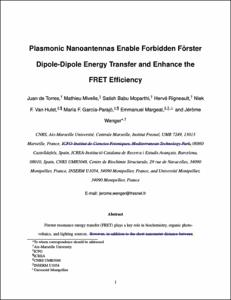Mostra el registre d'ítem simple
Plasmonic Nanoantennas Enable Forbidden Förster Dipole-Dipole Energy Transfer and Enhance the FRET Efficiency
| dc.contributor.author | Torres, Juan de |
| dc.contributor.author | Mivelle, Mathieu |
| dc.contributor.author | Babu Moparthi, Satish |
| dc.contributor.author | Rigneault, Hervé |
| dc.contributor.author | van Hulst, Niek F. |
| dc.contributor.author | Garcia-Parajo, Maria F. |
| dc.contributor.author | Margeat, Emmanuel |
| dc.contributor.author | Wenger, Jérôme |
| dc.contributor.other | Universitat Politècnica de Catalunya. Institut de Ciències Fotòniques |
| dc.date.accessioned | 2018-08-27T11:23:50Z |
| dc.date.available | 2018-08-27T11:23:50Z |
| dc.date.issued | 2016-09-13 |
| dc.identifier.citation | Torres, J. D. [et al.]. Plasmonic Nanoantennas Enable Forbidden Förster Dipole-Dipole Energy Transfer and Enhance the FRET Efficiency. "Nano Letters", 13 Setembre 2016, vol. 16, núm. 10, p. 6222-6230. |
| dc.identifier.issn | 1530-6984 |
| dc.identifier.uri | http://hdl.handle.net/2117/120599 |
| dc.description | Förster resonance energy transfer (FRET) plays a key role in biochemistry, organic photovoltaics, and lighting sources. FRET is commonly used as a nanoruler for the short (nanometer) distance between donor and acceptor dyes, yet FRET is equally sensitive to the mutual dipole orientation. The orientation dependence complicates the FRET analysis in biological samples and may even lead to the absence of FRET for perpendicularly oriented donor and acceptor dipoles. Here, we exploit the strongly inhomogeneous and localized fields in plasmonic nanoantennas to open new energy transfer routes, overcoming the limitations from the mutual dipole orientation to ultimately enhance the FRET efficiency. We demonstrate that the simultaneous presence of perpendicular near-field components in the nanoantenna sets favorable energy transfer routes that increase the FRET efficiency up to 50% for nearly perpendicular donor and acceptor dipoles. This new facet of plasmonic nanoantennas enables dipole–dipole energy transfer that would otherwise be forbidden in a homogeneous environment. As such, our approach further increases the applicability of single-molecule FRET over diffraction-limited approaches, with the additional benefits of higher sensitivities and higher concentration ranges toward physiological levels. |
| dc.format.extent | 8 p. |
| dc.language.iso | eng |
| dc.publisher | ACS |
| dc.rights | Attribution-NonCommercial-NoDerivs 3.0 Spain |
| dc.rights.uri | http://creativecommons.org/licenses/by-nc-nd/3.0/es/ |
| dc.subject | Àrees temàtiques de la UPC::Física |
| dc.subject.lcsh | Antennas (Electronics) |
| dc.subject.other | antennas |
| dc.title | Plasmonic Nanoantennas Enable Forbidden Förster Dipole-Dipole Energy Transfer and Enhance the FRET Efficiency |
| dc.type | Article |
| dc.subject.lemac | Antenes |
| dc.description.peerreviewed | Peer Reviewed |
| dc.relation.publisherversion | https://pubs.acs.org/doi/abs/10.1021/acs.nanolett.6b02470 |
| dc.rights.access | Open Access |
| dc.description.version | Postprint (author's final draft) |
| dc.relation.projectid | info:eu-repo/grantAgreement/EC/FP7/247330/EU/Nano-Optical Antennas for Tuneable Single Photon Super-Emitters/NANOANTENNAS |
| dc.relation.projectid | info:eu-repo/grantAgreement/EC/FP7/247330/EU/Nano-Optical Antennas for Tuneable Single Photon Super-Emitters/NANOANTENNAS |
| dc.relation.projectid | info:eu-repo/grantAgreement/EC/H2020/670949/EU/LightNet/LightNet |
| dc.relation.projectid | info:eu-repo/grantAgreement/EC/FP7/288263/EU/Advanced photonic antenna tools for biosensing and cellular nanoimaging/NANO-VISTA |
| dc.relation.projectid | info:eu-repo/grantAgreement/EC/FP7/278242/EU/Extended fluorescence resonance energy transfer with plasmonic nanocircuits/EXTENDFRET |
| local.citation.publicationName | Nano Letters |
| local.citation.volume | 16 |
| local.citation.number | 10 |
| local.citation.startingPage | 6222 |
| local.citation.endingPage | 6230 |
Fitxers d'aquest items
Aquest ítem apareix a les col·leccions següents
-
Articles de revista [35]


